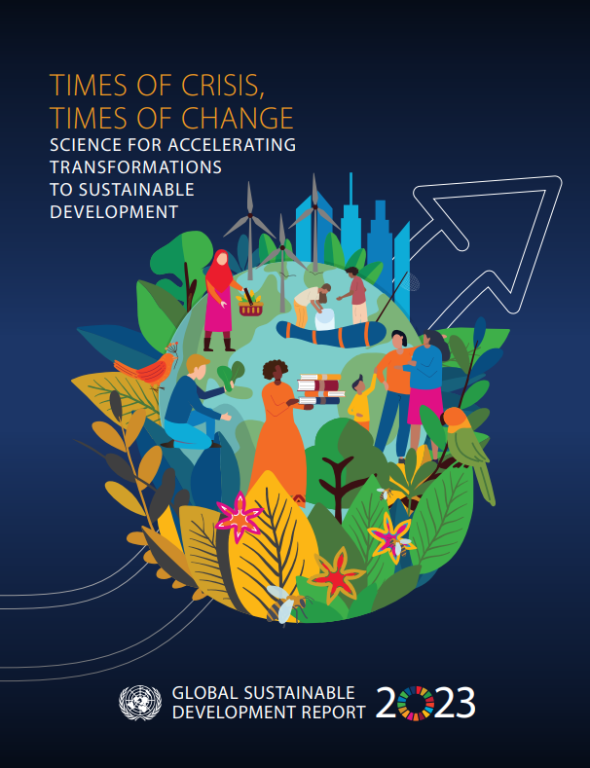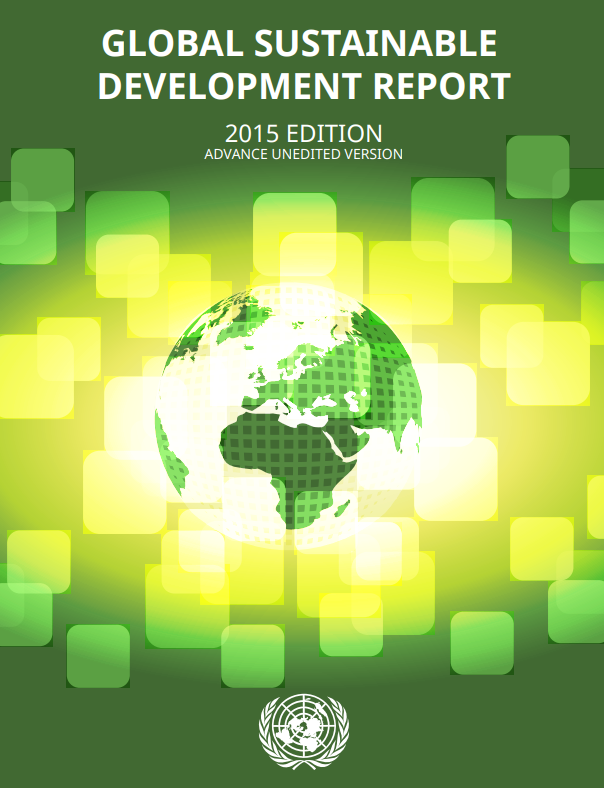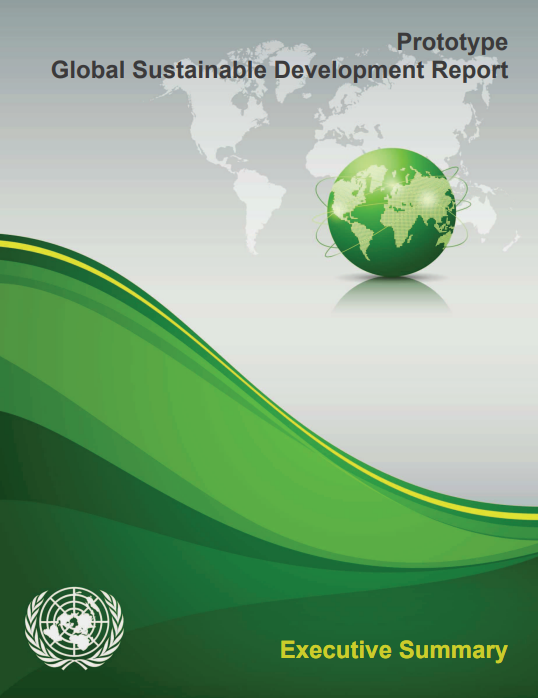Home
Launch of the Global Sustainable Development Report 2023
12th September, New York - The Global Sustainable Development Report 2023, prepared by the Independent Group of Scientists, was launched on Tuesday 12th September at 12:30pm EST in the UN Press Briefing Room. The report builds on the 2019 report providing evidence that can help decision-makers to accelerate action and overcome impediments that stand in the way of progress on sustainable development. The focus is on accelerating transformation through important entry points and enabling science to support this acceleration. The live broadcast of the report launch can be viewed via UN Web TV.
Background
The Global Sustainable Development Report (GSDR) is a United Nations publication aiming to strengthen the science-policy interface at the High-Level Political Forum (HLPF) on Sustainable Development, the main United Nations platform providing political leadership and guidance on sustainable development issues at the international level. It is one of the only two mandated reports to inform the decision-making process at the HLPF.
- The GSDR adopts an assessment-of-assessments approach, documenting and describing the landscape of information on specific issues that are policy-relevant in the field of sustainable development, bringing together dispersed information and assessments.
- The GSDR is complementary to other assessments and substantive reports being prepared by the UN system and other institutions; it draws upon contributions from a wide range of experts and stakeholders from across the world, bringing together diverse perspectives and disciplinary backgrounds.
- The GSDR is global in coverage while taking into account the perspectives of the five UN regions.
- In developing the GSDR, extensive inputs are sought from within the UN system, as well as from external experts including scientists, government officials and stakeholders at all levels, including representatives of academies of sciences and relevant expert groups.
Building on three prototype editions of the GSDR in 2014, 2015 and 2016, in the Ministerial Declaration of the 2016 HLPF, Member States decided that the GSDR should be produced once every four years to inform the quadrennial SDG review deliberations at the High-Level Political Forum under the auspices of the General Assembly, and that it should be written by an Independent Group of Scientists (IGS) appointed by the Secretary-General. The IGS would consist of 15 experts representing a variety of backgrounds, scientific disciplines and institutions, ensuring geographical and gender balance. It would be supported by a task team of six UN entities (UN DESA, UNCTAD, UNDP, UNEP, UNESCO and the World Bank).
Scope and methodology
- Ministerial Declaration 2016 Annex: Global Sustainable Development Report: scope, frequency, methodology and relationship with the Sustainable Development Goals progress report
- Letter from the President of ECOSOC on the process of consultations on the scope, methodology and frequency of the Global Sustainable Development Report
- Background note for consultations on the scope, methodology and frequency of the Global Sustainable Development Report (GSDR)
- E/2014/87 - Options for scope and methodology for a global sustainable development report
[عربي] [中文] [English] [Français] [Русский] [Español]
Mandates
2012 As outlined in the Rio+20 outcome document, the HLPF would, as one of its functions, "strengthen the science-policy interface through review of documentation bringing together dispersed information and assessments, including in the form of a global sustainable development report, building on existing assessments" (§85k).
2013 General Assembly resolution A/RES/67/290 of 9 July 2013 confirmed the role of the GSDR and requested “…the forum to consider, in 2014, the scope and methodology of a global sustainable development report, based on a proposal of the Secretary-General reflecting the views and recommendations of Member States, and relevant United Nations entities…”.
2014 In response to resolution A/67/290, all Member States, political groups and all 53 UN organizations of ECESA-Plus were invited to make proposals on the scope and methodology of a global sustainable development report. The views expressed were summarized in Secretary General’s report E/2014/87 of June 2014. The report synthesized the positions of Member States and other stakeholders on the scope, methodology and frequency of the report. The report also proposed three broad options for the GSDR going forward: option 1: Conventional UN flagship publication model; option 2: Multi-stakeholder, multi-level approach; option 3: Approach following that of the IPCC. Option 1 was the least resource intensive and option 3 the most costly. A prototype GSDR, issued in June 2014, was prepared by the Secretariat. At the second meeting of the HLPF under the auspices of ECOSOC, the Prototype GSDR was presented to Member States, and the scope and methodology of the GSDR were discussed. Preference was expressed for a multi-stakeholder, multi-level approach to preparing future reports.
- E/2014/87 - Options for scope and methodology for a global sustainable development report
[عربي] [中文] [English] [Français] [Русский] [Español]
2015 A second edition of the report, published in June 2015, was prepared by the UN Secretariat. Consistent with the expressed preference of Member States as summarized in the SG’s Report, the approach adopted was a multi-stakeholder one, documenting and describing the landscape of information on specific issues, based on extensive inputs from the UN system, the scientific community, including scientists involved in key international assessments, government officials and stakeholders at all levels.
“Transforming our world: the 2030 Agenda for Sustainable Development” (A/RES/70/1) paragraph 83 “Follow-up and review at the HLPF will be informed by an annual SDG Progress Report to be prepared by the Secretary General in cooperation with the UN System, based on the global indicator framework and data produced by national statistical systems and information collected at the regional level. The HLPF will also be informed by the Global Sustainable Development Report, which shall strengthen the science-policy interface and could provide a strong evidence-based instrument to support policy-makers in promoting poverty eradication and sustainable development. We invite the President of ECOSOC to conduct a process of consultations on the scope, methodology and frequency of the Report as well as its relation to the SDG Progress Report, the outcome of which should be reflected in the Ministerial Declaration of the HLPF session in 2016.”
2016 The Secretariat prepared GSDR 2016, which informed the 2016 HLPF. The President of ECOSOC conducted a process of consultations on the scope, methodology and frequency of the Report as well as its relation to the SDG Progress Report, the outcome of which was endorsed by the Ministerial Declaration of the 2016 HLPF (E/HLS/2016/1). The GSDR will be produced once every four years to inform the quadrennial SDG review deliberations at the High-Level Political Forum under the auspices of the General Assembly, and it should be written by an Independent Group of Scientists (IGS) appointed by the Secretary-General. It was mandated that the Group would consist of 15 experts representing a variety of backgrounds, scientific disciplines and institutions, ensuring geographical and gender balance. Resolution 70/299 of the General Assembly reaffirmed the quadrennial schedule of the GSDR as an input to the HLPF.
- Ministerial Declaration 2016 Annex: Global Sustainable Development Report: scope, frequency, methodology and relationship with the Sustainable Development Goals progress report
- Letter from the President of ECOSOC on the process of consultations on the scope, methodology and frequency of the Global Sustainable Development Report
- Background note for consultations on the scope, methodology and frequency of the Global Sustainable Development Report (GSDR)






